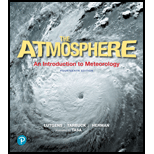
The reason why it is important to monitor all parts of the climate system.
Answer to Problem 1RQ
The Earth system is a complex combination of various spheres of the Earth. Even the minor changes in any of the system influence the other system in one way or the other. The climate does not merely deal with the atmosphere. The exchange of energy that occurs between these spheres results in the change in climatic system. Hence, it is important to monitor all parts of the climate system.
Explanation of Solution
The Earth system is a complex combination of various spheres of the Earth. Even the minor changes in any of the system influence the other system in one way or the other. The climate does not merely deal with the atmosphere.
Climate is defined as the long-term aggregate of average atmospheric conditions. It is the combination of relatively longer weather conditions. The climatic system includes the atmosphere, hydrosphere, geosphere, and biosphere.
The cryosphere is a part of the Earth's surface, where the water is in the solid form. This includes sea ice, glaciers, snow, fresh ice, and the frozen ground, which is called permafrost. The exchange of energy that occurs between these spheres results in the change in the climatic system.
Want to see more full solutions like this?
Chapter 14 Solutions
The Atmosphere: An Introduction to Meteorology (14th Edition)
- Subject: Hydrogeology Please answer both parts of the question correctly and in detail and show all workarrow_forwardDiscussion Question: Climate Change A+ The link below explains how scientists study past climates. After the introduction, there are 6 more links within the web page. Please go over each of the six links. Then, write one paragraph about each link explaining what you learned in your own voice. You should end up with 6 paragraphs total. http://earthobservatory.nasa.gov/Features/Paleoclimatology/paleoclimatology_intro.php Please always write in your own words and hence, your own voice. Plagiarism is completely unnecessary.arrow_forward1. List the five REASONS for seasons. Please be careful. I am not looking for INFLUENCES on seasons such as, Global Warming and winds. Think about axial parallelism, for example. (20 points). 2. Are we closest to the sun during the Northern Hemisphere summer or winter (5 points)? Is it called the aphelion or the perihelion (5 points)? 3. When does everyone receive 12 hours of day and 12 hours of night (5 points)? 4. During what Northern Hemisphere season do the penguins in Antarctica (the Southern Hemisphere) receive 24 hours of darkness (5 points)? 5. The water molecule is polar with two offset hydrogen atoms bonded to one oxygen atom. What are two characteristics or properties of the water molecule due to its polarity (10 points)? 6. The dew point temperature is 68 degrees Fahrenheit. Relative humidity is at 50%. Saturation vapor pressure is 24 millibars. What is the actual vapor pressure in the air in units of millibars? It is not a trick question. Look in the textbook under…arrow_forward
- Discussion Question: Ecosystems Essentials A+ of 1000 Exof-spil OCEAN The Human Denominator Assignment As we learn about how the earth works, we learn to identify the different earth spheres and how they overlap and affect one another. An understanding of the Earth's systems and spheres takes practice. More importantly, we can see the "Domino Effect" of the spheres as they interact with one another. We have learned that while endogenic processes are separate from exogenic process, the lithosphere affects the atmosphere which affects the hydrosphere, and the biosphere. Now, we can reverse the situation and consider how the biosphere, you and I, affectarrow_forwardGo to the following link. https://climate.nasa.gov/evidence/ Read over all of the links about the Climate Evidence, Causes, and Effects. Then, write a 15-20 sentences about what you learned.arrow_forwardPart C. Can someone draw and explain the steps to help with my understanding.arrow_forward
 Applications and Investigations in Earth Science ...Earth ScienceISBN:9780134746241Author:Edward J. Tarbuck, Frederick K. Lutgens, Dennis G. TasaPublisher:PEARSON
Applications and Investigations in Earth Science ...Earth ScienceISBN:9780134746241Author:Edward J. Tarbuck, Frederick K. Lutgens, Dennis G. TasaPublisher:PEARSON Exercises for Weather & Climate (9th Edition)Earth ScienceISBN:9780134041360Author:Greg CarbonePublisher:PEARSON
Exercises for Weather & Climate (9th Edition)Earth ScienceISBN:9780134041360Author:Greg CarbonePublisher:PEARSON Environmental ScienceEarth ScienceISBN:9781260153125Author:William P Cunningham Prof., Mary Ann Cunningham ProfessorPublisher:McGraw-Hill Education
Environmental ScienceEarth ScienceISBN:9781260153125Author:William P Cunningham Prof., Mary Ann Cunningham ProfessorPublisher:McGraw-Hill Education Earth Science (15th Edition)Earth ScienceISBN:9780134543536Author:Edward J. Tarbuck, Frederick K. Lutgens, Dennis G. TasaPublisher:PEARSON
Earth Science (15th Edition)Earth ScienceISBN:9780134543536Author:Edward J. Tarbuck, Frederick K. Lutgens, Dennis G. TasaPublisher:PEARSON Environmental Science (MindTap Course List)Earth ScienceISBN:9781337569613Author:G. Tyler Miller, Scott SpoolmanPublisher:Cengage Learning
Environmental Science (MindTap Course List)Earth ScienceISBN:9781337569613Author:G. Tyler Miller, Scott SpoolmanPublisher:Cengage Learning Physical GeologyEarth ScienceISBN:9781259916823Author:Plummer, Charles C., CARLSON, Diane H., Hammersley, LisaPublisher:Mcgraw-hill Education,
Physical GeologyEarth ScienceISBN:9781259916823Author:Plummer, Charles C., CARLSON, Diane H., Hammersley, LisaPublisher:Mcgraw-hill Education,





